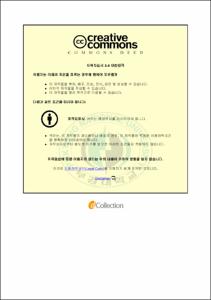NaCl 및 H2SO4 수용액에서 Al-Si계 합금의 전기화학적 특성에 미치는 합금원소의 영향
- Alternative Title
- Effect of the chemical composition on the electrochemical characteristics of Al-Si alloys in
- Abstract
- 0.6N NaCl, 0.6N H2SO4 수용액에서 Al-Si 합금들의 부식거동을 SEM-EDS 및 XRD를 이용하여 분석하였다. 알루미늄 합금들의 조성은 (1) Al7Si0.1Cu0.4Mg 합금과 (2) Al9Si2.2Cu0.1Mg 합금이다. 시험편의 동전위 분극곡선은 0.6N NaCl과 H2SO4 수용액에서 측정되었다. 합금들은 NaCl 수용액에서 전형적인 활성상태를 나타내었으며, H2SO4 수용액에서는 부동태 상태를 나타내었다. Al-Si 합금들은 각 수용액에서 표면에 각각 부식산화물을 형성한다. XRD 결과로 합금들은 0.6N NaCl 수용액에서 알루미늄 수화물을 생성하는 반면 0.6N H2SO4 수용액에서는 알루미늄 산화물, 알루미늄 황화물을 생성하는 것으로 나타났다.
부식전위 (Ecorr), 부동태 전위(Ep)와 부식전류밀도(Icorr)의 전기화학적 값들을 평가하였다.
Al-Si 합금들은 β(Al0.5Fe3Si0.5), π(Al8Si6Mg3Fe), θ’(Al2Cu) 와 Mg2Si 의 다른 알루미늄 화합물을 가지며 합금원소의 양에 따라 형성되어진다.특정 알루미늄 금속간화합물 β(Al0.5Fe3Si0.5), π(Al8Si6Mg3Fe), θ’(Al2Cu)은 알루미늄의 내식성에 안좋은 영향을 미친다. 특히, Cu와 Fe 화합물들은 수용액내의 부식환경에서 공식이나 입계 부식자리로 나타났다.
The corrosion behaviour of Al-Si alloys were investigated in an aqueous (0.6N NaCl, 0.6N H2SO4) solution at room temperature using SEM-EDS and XRD. The composition aluminum alloys were (1) Al7Si0.1Cu0.4Mg alloy and (2) Al9Si2.2Cu0.1Mg alloy. Potentiodynamic polarization curves of tested materials in 0.6N NaCl and H2SO4 solution have been measured. These alloys in NaCl aqueous solution exhibited typical active, in H2SO4 aqueous solution exhibited passive behavior. The Al-Si alloys have respectively corrosion oxide on surface in each aqueous solution. The XRD results showed that alloys generates aluminum hydroxide in 0.6N NaCl solution while alloys produce aluminum oxide, aluminum sulfate in 0.6N H2SO4 solution.
The electrochemical values of corrosion potential(Ecorr), passive potential(Ep) and corrosion current density(Icorr) were examined.
The Al-Si alloys have different aluminum compounds β(Al0.5Fe3Si0.5), π(Al8Si6Mg3Fe), θ’(Al2Cu) and Mg2Si to be formed according to the amount of alloying elements. So, The particular aluminum intermetallic compounds β(Al0.5Fe3Si0.5), π(Al8Si6Mg3Fe) and θ’(Al2Cu) give a bad profit to their corrosion resistance. Especially, Included copper and iron compounds showed that pitting corrosion and grain boundary corrosion site in aqueous soliutions.
- Issued Date
- 2015
- Awarded Date
- 2015. 2
- Type
- Dissertation
- Publisher
- 부경대학교 대학원
- Alternative Author(s)
- Sang-Hyun Woo
- Affiliation
- 부경대학교 대학원 신소재시스템공학과
- Department
- 대학원 신소재시스템공학과
- Advisor
- 이병우
- Table Of Contents
- Abstract
1. 서론 - 1
2. 이론적 배경 - 3
2.1 알루미늄 합금의 특성 - 3
2.2 알루미늄 합금의 전기화학적 특성 - 9
2.3알루미늄 합금의 부식 특성 - 14
2.4 알루미늄 합금과 부동태 - 19
2.4.1 부동태 피막의 형성과 파괴 - 22
2.4.2 동전위 분극곡선 - 25
3. 실험방법 - 27
3.1 재료의 선정 및 제작 - 27
3.2 부식 실험 시편 - 27
3.3 분극 실험 장치 - 31
4. 실험결과 - 34
4.1 합금의 미세조직 사진 - 34
4.2 합금의 분극 곡선 - 36
4.2.1 0.6N NaCl수용액에서 합금의 분극 곡선 - 36
4.2.2 0.6N H2SO4수용액에서 합금의 분극 곡선 - 40
4.3 합금들의 부식표면 - 44
4.3.1 0.6N NaCl 수용액에서 합금의 부식형상 - 44
4.3.2 0.6N H2SO4 수용액에서 합금의 부식형상 - 49
4.4 합금들의 부식 표면 성분분석 - 53
5. 결론 - 63
6. 참고문헌 - 65
- Degree
- Master
- Files in This Item:
-
-
Download
 NaCl 및 H2SO4 수용액에서 Al-Si계 합금의 전기화학적 특성에 미치는 합금원소의 영향.pdf
기타 데이터 / 3.24 MB / Adobe PDF
NaCl 및 H2SO4 수용액에서 Al-Si계 합금의 전기화학적 특성에 미치는 합금원소의 영향.pdf
기타 데이터 / 3.24 MB / Adobe PDF
-
Items in Repository are protected by copyright, with all rights reserved, unless otherwise indicated.